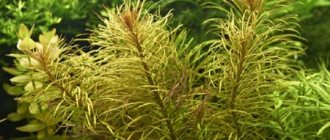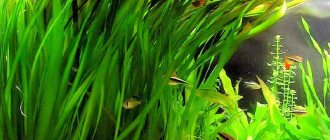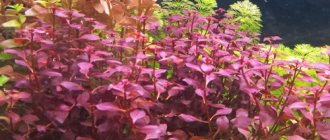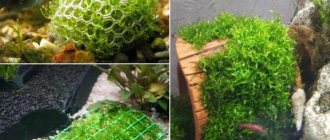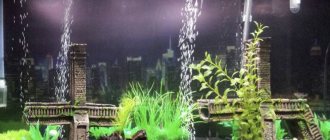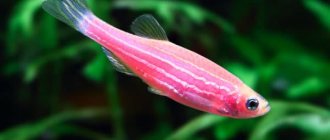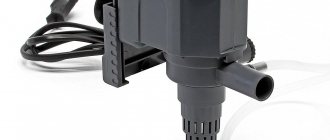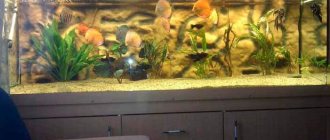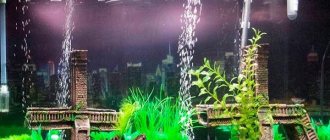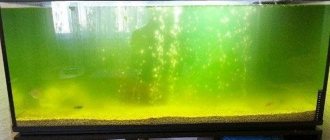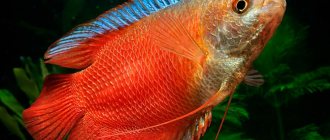Aquarium plants are aquatic species of flora that are cultivated in an aquarium (mainly freshwater). Most of these aquatic plants are of tropical origin and belong to marsh or coastal species - i.e. They are quite capable of being both submerged in water and rising above the surface of the water.
An aquarium with fish can decorate and enliven the interior of any apartment or public institution. Contemplating this small aquatic ecosystem in your own home is calming, gives you a feeling of comfort, and puts you in a positive mood. In addition to various animals (fish, snails), aquatic plants are also present in the aquarium. Depending on the type, they can be completely hidden under water or partially above it, attached to the ground or float independently in the water. Aquarium plants are mainly flowering plants, but there are also representatives of other divisions (mosses and ferns).
Breeding aquarium plants
For the growth and development of aquarium plants, as for any other photosynthetic plants, certain conditions are necessary. There are not many of them, but these requirements must be met in order for the aquarium to please the eye with lush green underwater vegetation.
First of all, you need to pay attention to the quality of the soil and substrate (a nutritious soil mixture with the necessary set of microelements) for the future aquarium. A wide range of substrates can be used and are suitable for most types of aquatic flora.
An equally important factor in plant life is sufficient lighting. To ensure this, special phytolamps are used: halogen, sodium, fluorescent, LED and incandescent lamps. The choice of lamp type depends on the plants to be grown. For example, for the less demanding cryptocoryne, echinodorus, ludwigia, hornwort, and many types of moss, moderate lighting from a fluorescent lamp is sufficient.
For full growth, carbon dioxide is also needed, which usually reaches plants in insufficient quantities from air and water. The way out of the situation would be to force the supply of CO2 using special equipment or by injecting carbon fertilizer.
Reproduction of aquarium plants - video
The most unpretentious plants
Seaweed
We are constantly not happy that algae appears on the walls of the aquarium and we fight against it, but this beautiful representative is the complete opposite of them. Cladophora is the only species that adds mystery to the underwater world.
The filamentous algae forms a whole colony in the form of a green lush ball that shrinks, picturesquely adding variety to the aquarium design. The ball can be divided into parts and attached to the very bottom, thereby creating a small lawn or rug. Small fish and shrimp are simply delighted with cladophora, because they not only hide in the algae, but also find nutritional microorganisms there.
Cladophora needs lighting from 0.5 W/l, neutral, medium hardness, clear, clean water. Prefers coolness and loses its shape in a warm environment.
Therefore, if decorative algae lives in warm water, then every month it must be placed in a cool environment to maintain the colony.
Java decorative moss
Java moss is a champion among unpretentious aquarium plants. It tolerates lack of light, varying acidity levels, and temperature well. It can live on the surface, in water, and is easily attached to objects with fishing line.
But if there is insufficient light, it is better not to place Java moss at the very bottom, because the light penetrating through the water will not be enough for the persistent beauty. Heavily polluted water is harmful to the Javanese, when organic particles settle on its leaves, covering it with a coating, depriving it of oxygen and the possibility of photosynthesis.
Aquarium floating plants
Floating plants of this subgroup live only on the water surface. They have a root system that hangs into the water column, through which the plant receives the nutrition it needs. Such vegetation blooms very often, decorating the surface of the aquarium with its pristine beauty. The most interesting representatives of such flora: duckweed, floating riccia, frogwort.
Duckweed and frogweed resemble clover. Duckweed is a variety of small plants. Experienced aquarists often refuse this flora, since it is almost impossible to get rid of it. Duckweed reproduces from a separate stem or leaf. But the flower is a reliable shelter for the fry, providing them with adequate nutrition.
The frogfish looks like duckweed, only a little larger and can be easily removed from the aquarium. To decorate the underwater world at home, riccia is most often used - small lumps of lacy green moss, but in other characteristics it is similar to duckweed. The plant does not like powerful lamps placed close to the surface of the water. In case of strong growth on the surface, Ricci is simply removed with the palms of the hand.
Beautiful ferns
Unpretentious aquarium plants include Indian and Thai ferns.
The wing-shaped, Thai plant has beautiful embossed leaves, shaped like willow leaves. Such flora grows very slowly, eventually forming lush, bushy bright green thickets about 30 cm high. It is mainly placed near the walls, in the corners and in the back landscape of the aquarium.
The bush can be placed in the center. The plant does not require special soil, since its roots do not penetrate deep into the soil. Ferns can be used to decorate decorations or driftwood, creating a fun design, for example, the ruins of a castle with trees penetrating through it.
This type of fern lives under lighting levels of 0.5 W/l, in warm, soft, slightly acidic or neutral water. Does not tolerate massive and constant water changes.
The Indian water fern is different in appearance from its counterpart. It has openwork, dissected light green leaves, the root system is well developed, it forms into a tall, large bush. But its growing conditions are similar to the Thai representative. Nutritious soil is required, the layer thickness is at least 4 cm.
Aquarium hornwort
This plant is capable of living in both tropical and cold environments. Hornwort is presented as a group of large numbers of plants floating on top of the water or growing securely attached to the decoration.
The plant grows quite quickly in size, providing reliable protection for the small inhabitants of the aquarium and fry. Its reproduction does not depend on the aquarist; a small part simply departs from the mother sprout.
Flowering aquarium plants
These representatives include numerous green inhabitants of the home underwater world. There is a variety of sizes, shapes, colors that sometimes it’s even difficult to make a choice. To do this, it is worth considering several of the most prominent representatives of this group, taking into account their decorative role in the aquarium.
Curvy funny ass
The plants are quite large in size and are used to decorate the landscape and the side walls of the aquarium. Polyspermous Hygrophila, a hardy species, is popular among aquarists due to its pointed, long, light-colored leaves.
It feeds on nutritious microorganisms, collecting them from the entire surface, helping to reduce the level of phosphorus and harmful nitrogen compounds in the aquarium. Favorite food for snails and herbivorous fish species.
Prefers fine soil of small fractions, a temperature of about 24 degrees Celsius, water of medium hardness, medium lighting. Calmly treats any level of acidity.
Direct hygrophila
The sister of this representative is direct hygrophila, lemongrass or simple nomaphila, a little more decorative: in bright light the border takes on a bright pink hue, they are located close to each other, with good care the plant forms a bush. Schisandra peeks out of the water, which gives the aquarium an interesting appearance.
Planting and maintaining aquarium plants
Plants in an aquarium are an important and complete part of the entire system. With proper provision of aquarium flora, the fish will be bright and beautiful. Residents become healthier and begin to feel more comfortable living a natural life.
Of course, living plants are not a plastic substitute and require a little more attention, but they can last much longer than plastic. Even if certain problems arise, live plants are preferable - they will serve as a full-fledged decoration if the entire aquarium system is properly organized (sufficient light and the absence of herbivorous abodes).
Both an ordinary natural pond and a home aquarium system become home not only to animals and fish, but also to a large number of plants. And it is the plants that prevent algae from multiplying and saturate the water with oxygen, while absorbing nitrogenous emissions.
There are no particular difficulties in keeping plants in an aquarium - they, just like living inhabitants, need clean water, proper soil and a sufficient level of lighting - and it is imperative to correctly select each of the indicators depending on the type of plant.
Tenth place - Ludwigia
Ludwigia is a beautiful plant of the Fireweed family, which is common in many home ponds. Often found in artificial ponds and aquariums. Ludwigia is native to warm tropical or subtropical waters. There are 75 species of this plant. In an aquarium, it can be kept either free-floating or rooted in the ground. Many species like to be above water. Ludwigia creeping, Ludwigia tornado, green and Ludwigia “Super Red” are the most spectacular representatives of fireweed.
Ludwigia repens is a beautiful plant with long stems, another name is Ludwigia repens. The leaf blades are oval-shaped, glossy. The leaf color is dark green above and reddish-purple below. Stem length – 40 cm. Prefers low water. It is better to plant at the rear walls of the tank, and it is advisable to plant Anubias nana and Cryptocoryne wendta in the foreground. Loves clean water. Sometimes the leaves become covered with an organic coating, which spoils its beauty. Regular water changes once a week are recommended. Creeping Ludwigia is saturated with bright light, which can be combined - periodically illuminate it with a lamp, periodically let the sun's rays shine on the plant. Ludwigia repens is an ideal shelter for fish such as guppies, gourami, and mollies.
How to grow an aquarium plant
If you don’t keep in mind rare species of aquarium plants, then you don’t foresee any particular difficulties in growing them in an aquarium. A novice aquarist will not need much: clean water and proper feeding combined with the right level of lighting. And if problems suddenly appear with the flora of the aquarium, then this can only mean one thing: some of these components were not of very high quality.
Before planting plants in the aquarium, you need to make sure that they are cleaned of all unnecessary things - algae and other dirt, and you should not forget about the dead parts of the plant, which also need to be trimmed.
Before planting, it is advisable to subject the plants to a disinfection procedure, which usually includes several options:
- placing potassium permanganate in a solution for a short time (20 minutes) - but you need to make sure that the solution is not too intense;
- providing an alum bath - it is recommended to place the plant in it for 5 minutes;
- A solution of hydrogen peroxide (one part to one part water) will give a good disinfecting effect.
And do not forget to thoroughly rinse the plant in clean water after the disinfection process.
Like all organisms, it is very important for plants in an aquarium to maintain the correct conditions for their prosperous life - you need to take into account the quality of the soil, the availability of nutrients, the degree of lighting, and the temperature of the water, its hardness and acidity. But you need to understand that algae and plants in an aquarium are not the same thing. Aquatic plants are higher flowering organisms, but algae are lower organisms (unicellular or multicellular). Algae never has flowers and can cause a lot of trouble for a new aquarium owner.
Eighth place - Cryptocoryne
Cryptocoryne is a genus of amphibious grasses that includes a wide variety of species growing in the tropics and subtropics. Belongs to the Araceae family.
Its name is based on a combination of two words:
- “crypto”, which means “hidden” in Latin;
- "koryne", which is translated from Greek as "cob".
This is a small bush of grass that has a horizontal root system. In natural conditions, there are terrestrial, floating or growing in water specimens. From a rosette of roots usually grows from 5 to 15 leaves on petioles.
The shape of the leaves varies from lanceolate to oval, the texture of the leaves can be either smooth or pimpled. The color range comes in different shades of green, brown or reddish. They have different lengths depending on the type and growing conditions (from 4 cm to 1.3 meters). Most often, the plant reproduces vegetatively: by root suckers or division of the rhizome, very rarely by seeds.
Its flower is shaped like a flute and has a small cob inside (up to 3 centimeters). However, aquarists usually have to be content with contemplating only the leaves of Cryptocoryne, since it is quite difficult to achieve its flowering in an aquarium.
In order for Cryptocoryne to bloom in aquarium conditions, you need to do the following:
- choose a flower pot with a diameter of 7 cm and fill it with a mixture of sand and gravel and the necessary fertilizers or ordinary garden soil, which should not contain lime and humus. Sprinkle decorative pebbles on top, add peat and plant an existing specimen of this species in them;
- fill the container with water up to 4 cm above the soil surface, place a pot with a plant in it and turn on the bottom heater for the soil.
If all these conditions are met, then this hydrophyte will throw out the inflorescence within a year.
This tropical grass is quite easy to care for. Almost all species do not need to frequently change the water to fresh water, but they can also grow with frequent changes. Suitable for aquariums without carbon dioxide supply and with poor lighting.
In principle, they can be planted both in a sunny place and in the shade. They grow well in silty soils.
For many species, it is enough to feed them with balls of clay and peat (or other water-insoluble fertilizers) and do without liquid fertilizers, which greatly contribute to the dominance of algae.
True, some types of cryptocorynes lose their decorative appearance without the addition of certain mineral supplements.
Its comparative unpretentiousness and high decorative value have made Cryptocoryne a fairly popular aquarium plant.
Important! Cryptocorynes do not tolerate sudden changes in environmental conditions. If you move the aquarium from a shady zone to a sunny one, change the temperature regime or water change regime, change the composition of the water, then most likely this will lead to plant disease.
Among the diseases of these plants, only one is distinguished, which is called “cryptocoryne disease.” The leaves of the plant become soft, lose their color and begin to rot and dissolve. This disease usually occurs when the environment of Cryptocoryne is greatly changed. It happens that this disease is spread by recently planted infected plants. If the rotting process has not affected the root rosette, then the plant can be saved.
If signs of this disease are detected, it is necessary to change all the water and clean the soil, remove diseased plants and rotten leaves. Over time, new ones will grow from the root rosette.
For a comfortable life in the aquarium, the following conditions should be created for this hydrophyte:
- pour about 5 cm of nutrient substrate; temperature regime in the range of 24-28°C;
- water acidity within 6.5-7.4;
- diffuse lighting 0.4-0.5 W/l;
- average water hardness 6-10°;
- change water and apply fertilizer weekly;
- transplant once a year.
Of course, these plants are not capricious and know how to adapt to other environmental conditions, but at the same time, the color and intensity of growth will most likely change.
Diseases of aquarium plants
Like any living organism, aquatic plants are susceptible to various diseases. They can be caused by various reasons, mainly by environmental factors. If the plant has any damage, then you first need to determine whether the damage is related to the activity of fish or snails. Next, you need to check whether the plants have enough available lighting. Its deficiency is expressed in thin stems, pale color of leaves and their discarding. And too much light makes the leaves small. Dense soil leads to blackening and death of roots.
The majority of diseases are associated with a lack of nutrients. Therefore, it is important to determine exactly which elements plants lack and make up for this deficiency.
Some diseases and their causes:
- If there is a lack of carbon, the plant may stop growing;
- Leaves with light and brown spots indicate a manganese deficiency;
- Blackness and mucus at the growing points - low calcium;
- Pale leaf color occurs due to iron deficiency;
- If the leaves become netted, then the plant does not have enough potassium;
- Leaves wither from lack of nitrogen and phosphorus;
- A lack of magnesium is expressed in the yellowness of the leaves and their further death in these places.
What else do plants need?
As noted before, unpretentious species are not demanding, so they need very little:
- presence of carbon dioxide;
- a small amount of light;
- micro- and macroelements;
- water that meets certain characteristics - acidity, optimal temperature, hardness.
Only if all these elements are present in the required quantity will the bushes and grass grow, live and please the eye, improving the habitat of the fish. But, for some species, creating certain conditions is quite difficult and requires knowledge, skills, and appropriate experience, so preference should be given to hardy plants.
Treatment of aquarium plants
The biological balance in the aquarium system is created by plants - after all, they are able to reduce the concentration of harmful substances in the water. It is plants that represent an additional link in this chain - and this link requires care and due attention.
Moreover, each of the aquarium owners (be it a professional or a beginner) sooner or later faces the issue of keeping plants in an aquarium - with their diseases and, as a result, treatment.
Of course, each disease and each plant has its own specifics - and there can be no general recommendations here. But there is only one, universal way to solve them - a visual inspection of the entire system, and most importantly, a clear understanding of all the processes occurring in the aquarium. This will help to track the slightest problems and stop them in time.
If it is necessary to maintain biological balance and ensure a healthy system of existence of the aquarium, it is necessary to very carefully monitor not only the fish and their general well-being, but also the condition of all other inhabitants of the aquarium - including plants. Only then will each of them feel optimal.
Functions of unpretentious plants
Living fauna helps maintain the home aquatic world in optimal condition, fulfilling its purpose, namely:
- decorate the aquarium;
- provide fish with a resting place and shelter from predatory neighbors;
- provide food to the inhabitants of the aquatic world;
- an excellent place for spawning and raising fry;
- increase the oxygen content in water;
- neutralize harmful substances, for example, such as ammonia;
- compete with lower vegetation, suppressing its development.
Simple and unpretentious does not mean ugly
Of course, plants grown with, let's say, a professional approach, cause admiration. But this does not mean that you cannot beautifully decorate an aquarium using the simplest types. With some imagination and patience, you can get very decorative aquariums, even using the set of plants given above. Below I will modestly present an old photo of one of my aquariums. Lighting here is provided using conventional energy-saving lamps. However, the plants come to be weeded every week. Parole was not used.
An example of decorating an aquarium with unpretentious and simple plants
Here we can give only a few well-known recommendations that should be followed.
- Long-stemmed plants look much better if they are planted in a bunch of several pieces; you should not plant them close to the front wall of the aquarium.
- Place large plants in the background.
- Ferns and mosses can be grown onto driftwood and stones and placed in more shaded areas. Hornwort and elodea grow well in a floating state; they do not need to be planted in the ground.
- There is a widespread belief that an aquarium should not be located near a window. With low-power lamps, moderate sunlight will only benefit the plants.
- Periodic water changes have a beneficial effect on plant growth. Since they receive the nutrients necessary for development with water changes.
- Try to maintain a balance between the inhabitants of the aquarium. There should be a lot of plants, but no fish. And not vice versa.
The rules are simple, but nonetheless working.
Differences between algae and aquatic plants
Beginners often mention so-called “healthy algae”. Unfortunately, there are no such things. What many call algae are aquatic plants - with real roots, stems and leaves. Some species have adapted to life in water, while others can live on land at the same time, producing several stems above the surface.
Let's look at the main differences between these two groups:
- Algae are the lowest form of life. They do not have full-fledged organs, multicellular individuals are not divided into real tissues - their cells are copies of each other.
- Algae reproduce by spores and cannot have flowers or seeds, like conifers. Higher aquatic plants do not have spores.
- Only real plants have roots, leaves, stems, and flowers.
Therefore, all decorative aquarium “algae” actually do not belong to this group.
